|
|
|
|
|
|
As
with Venice there's not much native Italian fiction
about Florence, or at least not much that's been translated into
English. So most of the recommendations are written by
smitten Brits and Americans. The Medici,
Machiavelli, Michelangelo, the Pazzi Conspiracy, the lives of
artists and their apprentices and Simonetta Vespucci. The usual
subjects mostly focus on the Renaissance. For novels written by
a native, dealing with working class life in
Florence between the wars, there's
Vasco Pratolini, whose works
were also much filmed. Marco Vichi writes crime novels set in
Florence in the 1960s. in Italian, but their translation rate
has ground to a halt of late. |
|
A-F |
|
G-K |
|

|
Tasha Alexander The Dark Heart of
Florence
|
|
Anne Charnock Sleeping Embers of an Ordinary Mind
Michael Dibdin A Rich
Full Death |
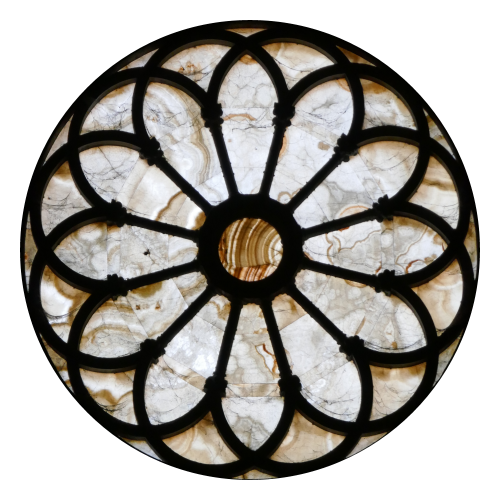
|
Michele
Giuttari A
Florentine Death Well, I tried, I really did. I managed to get past the flat and cliché-ridden prose, the unconvincing dialogue and the very ordinary characters. Also the fact that the lack of any descriptive talent was doing Florence no favours. I wasn't enjoying the book hugely but I was persevering, for your sake. But then on page 107 the cops recover a Velázquez portrait and our hero is impressed by how its eyes follow him around the room. I'm sorry but, as has been said before and often, life is too short. Also someone who managed to finish it had warned me that the lesbian character gets anally raped later on and enjoys it, and that there's also some gratuitous Thomas Harris-style stuff, involving gruesome torture implements and man-eating wolves. If this sounds like the sort of thing that you'd enjoy then be my guest. But not in my home. Much was made in this book's publicity material about Giuttari being involved in the Monster of Florence case, thereby making us feel we have to respect him for his real-life crime fighting chops. Imagine my joy then, when watching a TV documentary about the case, at discovering that he was, in fact, one of those taken in by the utterly foolish black magic theories. The film mentioned his criminal convictions for lying under oath too, and how he had a journalist arrested for pointing out his stupidity. It's somehow reassuring that my deep dislike for this book is born out by his turning out to be pretty much a dishonest hindrance to the solving of the case. More about the documentary here He's written five more novels since, but I'm not tempted. Brian Glanville Along the Arno Three young exiles wash up in post-war Florence. The blurb talks of a lost generation and a web of love, violence and frustration... but I do intend to read it one day, honest. |
Wilhelm Hauff The Severed Hand A macabre little story, about a young trader from Byzantium who deals in exotic fabrics and is also a Paris-trained doctor. Whilst living in Florence he gets a weird summons, acquires a gilt-decorated red leather cape and ends up tortuously sucked into committing a bizarre murder. The Florence detail is sparse (really just a meeting on the Ponte Vecchio) but it's a juicy tale by an author new to me, and worth the five minutes it'll take you to read it. You can find it for free on the Project Gutenberg website. Glenn Haybittle The Way Back to Florence We begin in 1943, with an artist in Florence disturbed at work by the noise of bombers flying over, then we switch to her husband, flying one of said Lancasters over Florence. So far so uncommon. We then slip back to 1937 and their relationship beginning, while they are both studying with the crusty and egotistical painter called the Maestro. There is also Oskar, a German Jew and a dancer with a daughter and Marina. The language has a tendency to be a bit, well, creative, especially in the first few chapters, but it settles down as the focus moves from art to atrocities, but always has a thing for stray sensual stimulations, sometimes in the least likely circumstances. And we get given good Florence, with plenty of evocative period detail, and city settings mostly around San Frediano and along the river. The infamous fascist torture centre in the Villa Triste in via Bolognese and the female prison in Santa Verdiana feature too. The suffering can get pretty relentless, but sadly in 2017 the need to be reminded remains, it seems, and the overall message here seems to be that when humanity, the concept, seems to have been banished, it still has the capacity to return and surprise. |
|
|
Lucretia
Grindle
The Faces of Angels It took me until Lockdown II in 2020 to get around to reading this one, the author's first Florence novel, and even to realise that I hadn't read it, despite having bought the paperback in 2007 (Amazon tells me) and read the other two in between. It's mostly about Anne, an American woman returning to Florence to lay the ghosts of her gruesome attack in the Boboli Gardens years before, which she only survived when her husband blundered along to save her and got killed himself. She comes back to stoke up a romance begun back then and to study art. The major early part of the novel sees her doing these things, stirred and screwed up by memories, and disturbed by priests and more murders. Blame it on lockdown-inspired impatience but I found more tedious stretches here than I remember from the author's other books. Like where she does that thing, like in horror films, where long drawn-out scenes create tension and fizzle out to show that sometimes irrational fears are just that. Or the similar long scenes where nothing much happens to progress the plot, and then it suddenly does. Detective Alessandro Pallioti is a memory for Anne, from his investigating the attack in the Boboli, the perpetrator of which died in a car crash soon after. Pallioti doesn't feature much until the long-threatened close-to-home contemporary murder takes place, so it'd be a stretch to call it a Detective Pallioti novel, and it's really more a psychological thriller than a police procedural. (The central character is a bit obsessed with dead WWII partisans too, seemingly for no other reason than to presage the author's later novels.) The longeurs (and tedious concentration on girly frock and accessory details) are more than made up for by the Florence content and art-history frissons - this one is very Florentine, the action centring around Santo Spirito. It's good, but she later wrote better later. Villa Triste
The Lost Daughter |
Tinney Sue Heath A Thing Done Robert
Hellenga
|
|
|
|
another sensitive loner - an unmarried writer of poetry - but
from well-tilled soil springs fresh life, with some believable and
likeable characters and a sharp plot. There are clever but
unobtrusive allusions that'll make you feel smart if you get
them. You will know the identity of the murderer pretty early on,
though, if you know anything about castrati, and putting the word
castrato in the title also spoils what could've been a shocking
revelation. The pacing works well by interspersing the murder
stuff with the experiences of Cordelia - an American woman who's
just dumped her unworthy husband to come to Florence to write her
doctoral thesis and rediscover herself. She develops as the plot
develops and her story is so perceptively written you might
almost suspect Mr Hill of being a Ms. The second in the Detective Carlo Abati series was Ghirlandaio's Daughter, which I read and reviewed after a visit to Lucca, where it is set, many years after reading The Last Castrato. |
|
|
|
||
|
Mary
Hoffman Stravaganza - City of Flowers The first book in the Stravaganza series City of Masks was set in an alternative Venice and I loved it. I later read City of Stars, the second one, set in an alterno-Siena. But way back when this one came out I got it sent to me as an advance uncorrected proof (my first!) to review, after the author herself made contact. It has characters from the previous two books, and new ones, hopping back and forth from a version of Renaissance Florence to 21st century North London. The plot hangs upon the impending marriage of various members of the fictionalised Medici family and the trouble expected, in the Pazzi conspiracy vein. Florence is very well evoked, fictionalised or not, with some nice changes - like Michelangelo being female - and other 'in-joke' touches for us fans to spot. And the flood towards the end is a scene not soon forgotten. I enjoyed this book but found it less emotionally engaging and more romantic and, if you'll pardon the expression, girly than the first one. (If I had a pound for every time someone blushed...I'd have more than twenty quid, I imagine.) But I'm no teenager, and not a girl, and so maybe I'm not this book's target audience. That's not to say there's not plenty to give pleasure to Florence fans here, and it still has the sharpness and humanity I enjoyed in the first one and so gets a warm recommendation. And which of us can say we wouldn't be better people if we were more in touch with a our inner (teenage) woman? There are now six Stravaganza books, taking in versions of Ravenna, Lucca and Padua too. See The Venice Questions on this very site for more about Stravaganza and Mary H's Venice. David  It's 1501 and Gabriele is a young stonecutter from out of town, come to Florence to find work and his brother the sculptor. Michelangelo is his milk - rather than blood - brother but is out of town. Gabriele is lucky enough to be taken in meantime by a wealthy widow who is happy to provide him with food and a warm bed, and who wants...very little in return. This little thing is provided warmly and willingly and, though not explicitly, this puts us quite swiftly into territory described on the back cover as Not suitable for younger readers. It's not surprising that the young man that modelled for Michelangelo's should be the object of more than the odd appreciative glance, and so it proves. His dalliances and modelling duties swiftly mix him dangerously well into Florence's complex network of political groupings and spying, beatings and denunciations ensue. There's art too, with wide-eyed visits to the Brancacci Chapel and San Marco. Later Leonardo turns up and things get really bitchy. All Renaissance life is here, then, seen from the point of view of a horny boy learning about life. And at the end of the book there is a definite sense of life lived and lessons learned. |
Nancy
Huston
Infrared Lena is a photographer who thinks herself an artist. She's meeting her father and step-mother in Florence to celebrate his 70th Birthday and see the sights and the art. Despite this somewhat sedate setup this is a book that throws a lot at you right from the start - sex, sadism, sexual abuse, power games, the Holocaust, bad parenting, life in the multicultural stews of the Paris projects, the varieties of Jewishness, the life of Pico de Mirandola ... it's all here, and within the first 50 or so pages. Depending on what you were reading before it can all be a bit breathtaking and our heroine can be a bit annoying and exhausting. But once you settle in and the sensitive observations start to smooth over the rough sex*, it's a book to savour. Having each of the places visited and works of art seen set Lena's mind spinning on key events and people in her life works surprisingly naturally and well, and allows the book to wear its knowledge quite lightly. (Although there is the odd slip-up, like saying that pietra serena is a cream-coloured stone.) So it gives very good Florence, covering all the usual bases - subjects and places and people - but does it with some added odd associations and stories. Lena remains hard to like and blokeishly self-obsessed and insensitive, but I know that this shouldn't matter. And the ending resolves nothing, really, although I know that this shouldn't matter. I hope that my review will tell you enough to decide whether you'll like the book even though, on balance, I didn't. *This book was nominated for, and won, the The Literary Review's Bad Sex Award in 2012, Nancy Huston thereby becoming only the third woman to win in the award's 20-year history. 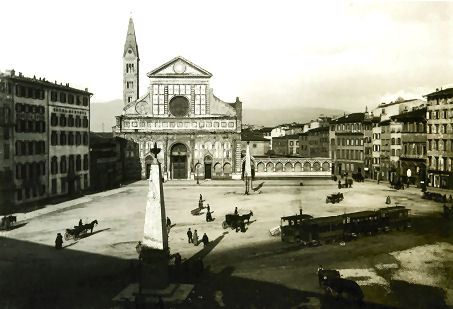 Henry James The Diary of a Man of Fifty A short story in which a man (of fifty) returns to Florence, from which city he fled twenty-five years before, from a relationship with an alluring woman that would, he thinks, have only made him miserable had he remained. He meets a young man in a similar situation, and the woman concerned is the daughter of his long-dead lost love. Old ground is gone over, new facts emerge, and history fails to repeat itself, maybe. A subtle and complex little tale, which subtly whiffs of Florence, without too much sight-seeing. |
|
|
Appetite
|
The Painter of Souls In which the author moves on from the life of an imaginary cook in Renaissance Florence to that of a real artist, also the uncle of the hero of Appetite, so this is something of a prequel to that book. This one concentrates on the (very) formative years in the life of Filippo Lippi, from his childhood running wild on the streets of the Oltrano through his life as a monk and, eventually, artist in the convent of the Carmine. The imagined personal and researched historic detailing is darn faultless and utterly convincing, and the meetings with the likes of Massacio and Donatello have a winningly genuine flavour. The account of life in the convent and of Fra Filippo's reaction to the work progressing on the Brancacci Chapel and his emotions confronting the images that appear will stick with me, I think, and tweak my perceptions on future visits. This novel may lack the intellectual rigour of A Gift for the Magus, Linda Proud's fictional life of Filippo, but is more concerned with emotion and motivation, and their being confused and mixed, respectively. The art methods are stronger here, too, and the author uses his poetic license to make one of Lippi's old friends the protagonist in one of Florence's more pungent stories, linked to the church of Santa Maria de' Ricci, and also towards the (satisfying) end, where some celebrities appear to surprise us all. The book ends with Fra Filippo's admission to the guild of painters and Masaccio's departure to Rome, the Brancacci chapel left unfinished, to be completed - spoiler alert - much later by Fra Filippo's son. So there's plenty more life to come in the promised later volumes, which are taking a while. The Phoenix of Florence 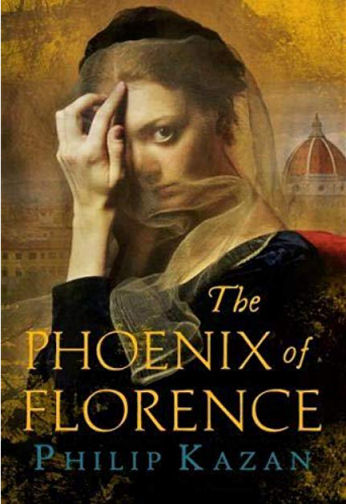 After the food and art variety of the above two books it's a bit of shock when this one plunges us straight into period crime territory, with some gory deaths on the Ponte Santa Trìnita in the Florence of Grand Duke Francesco de' Medici - the late-16th century. But as dim light begins to shine on the perpetrators Onorio Celavini, our policemen/narrator, turns out to be not all he seems too, and the story leaps back a few decades to his childhood, and the events that formed and drastically changed him. For me to too closely detail this would be a definite spoiler, but suffice it to say we delve deeply and fruitfully into issues of self-creation and sexual identity as we follow our hero through his time spent as a mercenary soldier fighting the French and the Turks, in Flanders and at Lepanto. Which means more action and blood than previously, and less time spent in Florence, but we do return there for a good third of the book. The Florentine locations cluster around Onorio's house near the Ognissanti, his workplace of the Bargello, and Santa Trìnita, with a couple of candle-lit funerals at night, which I presume is an authentic detail. A church called Sant'Ambrogio is mentioned too, but the real church of that name is over the other side of town so this may be some use of a poetical licence. We're well into the power and intrigue of warring families and factions by the end. And revenge. There's a lot about the ill-treatment of women here but, in the end, we reach a non-clichéd place. A good read indeed. |
|
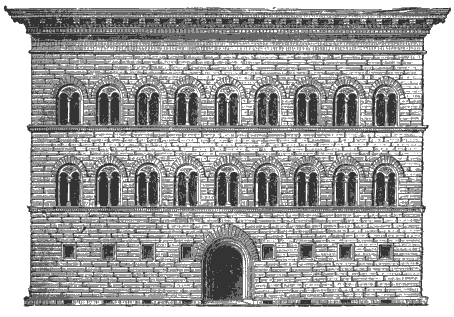
|
A Party in San Niccolo Well, after a pretty lean period for new novels set in Florence in 2003 came a real gem. There's a murder, or two, but this is not really a crime novel. It's more a book of characters and the way their lives connect, which is a major theme in crime novels, of course, but the story here isn't of police and procedure. The main character is Gina, an Englishwoman who's finding 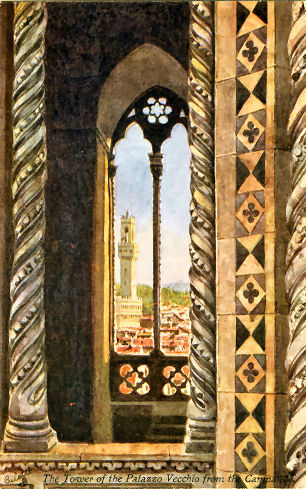 motherhood a little limiting, to say
the least, and escapes to stay in Florence at the austere home
of an old school friend and her austere and disturbing architect
husband. The first murder victim is a friend of her hosts'
daughter. As Gina socialises and shops and goes to stay in the
country the death and the subsequent investigation intrudes on,
and affects, the lives of the people she meets in different
ways, and these people in turn meet others... The young
people contemplate their messy lives as the old people look back
at their messy pasts. As the week progresses, the plot thickens
as preparations are made for the party of the title
(uncannily echoing the plot of
Mrs
Dalloway which I read just before this book.) Florence and
its tacky high life and lurid low life are described and evoked
with telling detail and conviction, and the characters convince
and breathe. An exceptionally good book. motherhood a little limiting, to say
the least, and escapes to stay in Florence at the austere home
of an old school friend and her austere and disturbing architect
husband. The first murder victim is a friend of her hosts'
daughter. As Gina socialises and shops and goes to stay in the
country the death and the subsequent investigation intrudes on,
and affects, the lives of the people she meets in different
ways, and these people in turn meet others... The young
people contemplate their messy lives as the old people look back
at their messy pasts. As the week progresses, the plot thickens
as preparations are made for the party of the title
(uncannily echoing the plot of
Mrs
Dalloway which I read just before this book.) Florence and
its tacky high life and lurid low life are described and evoked
with telling detail and conviction, and the characters convince
and breathe. An exceptionally good book.
A Florentine Revenge
A
Time of Mourning 1 |
The Dead Season 3 We begin by being introduced to our central characters: a beaten-up body on a roundabout, a woman called Roxana in a dead-end job at a small bank, and Sandro Cellini, involuntarily house-hunting. Cellini's detective business isn't exactly thriving, and it being a particularly dead and hot August doesn't help, so a pregnant woman whose man's disappeared counts as things looking up. Roxana in the bank has noticed that a regular - from the local porn cinema - hasn't been in to bank his takings today too. Are these things linked? As ever with Ms K the concentration here is on lives rather than deaths. And if I add that Cellini's wife is recovering well from her mastectomy, that the bank worker has a mother with borderline Alzheimer's, and that Cellini's assistant, Giuli, has got a new boyfriend and is feeling ill in the mornings you'll know that it's (dare I say?) female matters that again dominate. No bad thing, of course, but the strands can feel a bit smuggled in, bearing in mind that this is ostensibly a crime novel. When the body is found and the plot knots start to get truly tangled, though, the domestic details recede somewhat, only for the whole lot to come together in a rush of action and weather at the end. Florence breaths heavily and hotly all through, although this is a dingy and sweaty underbelly Florence, empty and gritty, rather than the gently glowing tourist version. You'll recognise the locations and the life-concerns and not dare resist caring and being swept along. A Darkness Descending 4 We begin with an unhappy young mother and a meeting in a disused church of a broadly green political group heartily sick of the existing order. The latter, truly timely, phenomenon is personified by Giuli, Cellini's assistant, adopted by him and his wife from a life on the streets and now mixing the political with the personal. Then Cellini's old partner's daughter decides it's time for a change of life. Matters move at a leisurely pace for the first quarter of the book, following the collapse of the green group's leader, and its hard to see where a crime might fit into these seemingly unconnected strands, mostly concerning women and their life choices. The focus is on the Oltrano district, the default area now for books about the lives of real Florentines. the Piazza Santo Spirito having the requisite real-lifeness in spades. The other plot centre is the area around the Botanical Gardens, San Marco and the University. As I say the strands seems too disconnected to become an eventual weave, but the Adam and Eve references build up, and a pleasingly unpredictable ending looms. The story is concerned far more with women than criminals, as ever in this series, but the grip on our (and the characters') emotions is as sure as ever. The Killing Room 5 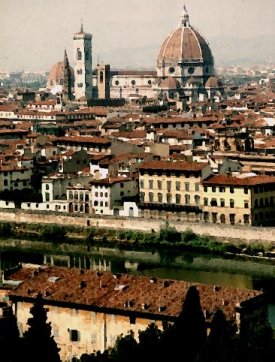 Sandro gets a day job as head of security for a the Palazzo San Giorgio, on which the paint is still wet from its conversion to luxury flats for the rich and nasty. His predecessor gets murdered, a dog disappears, a body is found in a suitcase and various characters are introduced who seem at first somewhat unconnected but... At the same time Giuli looks like losing her day job, as she is accused of shooting up on the job, and Sandro's wife gets assigned to looking after the shopping needs of the rich and nasty females. The crime-story structure is stronger here, with the personal-political and fashion-trade aspects less dwelled upon this time, initially. And then there's that melodramatic title. The action is still Oltrarno-centric, though, with the converted palazzo located up the hill on the left after you cross the Ponte Vecchio. The poisonous atmosphere in the palazzo is well evoked, with the reek of a grim past and a venomous present keeping everyone suspicious and twitchy. The twists and revelations mount up towards the end, but so do the emotion-tweaking bits. Well up to scratch. The Viper 6 This one sees Sandro back on the force to help investigate a triple murder connected to a hippy commune in the hills which was, way back in the 60s, a formative experience for our young hero. Luisa, his wife, who's given up her day job, has her reasons for feeling and getting involved too. And Giuli, now Cellini's partner in the private detective business, has her own problems. In fact everyone has problems here, everyone is damaged, haunted, sick and/or dying. The novel is full of too much of everything, for me, especially in the plotting with its constant shocks and twists. We all like to be challenged and stimulated, but this one just left me emotionally breathless. I've mentioned the centrality of female concerns in past reviews, and here Luisa's leaving her job means less frock talk, but there's still a good amount of gynaecology. In Florence the action is mostly on the Oltrano side, and out south into the hills, with some popping over the Arno to posher locales and ospedali. I'll just add the overly fevered and gothic evocations of run-down huts and farmhouses, making all the buildings just as haunted as the people. I'm just off for a lie down. Oh, I forgot to mention that this is billed as the last Sandro Cellini novel, which is probably for the best. |
|
|
|
||
|
Jane
Langton The
Dante Game |
|
Pilar
Molina Llorente The
Apprentice Paul
J. McAuley Pasquale's Angel
|
|
Death of an
Englishman 1 |
The
Marshal's Own Case
7
The Marshal Makes his Report 8
|
|
Some Bitter Taste 12 There's a return to smaller scale domestic crime in this one. It's August and it's broiling out on the streets of Florence, again. The Marshal is visited by a woman who thinks someone's been in her flat, and he visits an elderly wealthy Englishman who's final days seem wrapped in a strange sadness. Then there are the Albanian prostitutes. All these strands and themes connect in ways sometimes subtle and rarely obvious. But the Marshal's as grumpy and self-doubting as ever, and the whole thing is just so real - with no pat answers and no trite happy ending. The Innocent 13 Returning to the familiar Florence of Ms Nabb’s Marshal, especially after a three year gap, is like relaxing into a good warm bath, except when the bath turns out to be a hyacinth-choked pond in the Boboli Gardens with a woman’s body in it. Gruesome death in a familiar setting being even more disturbing than in strange locations of course. Having the crime committed in the Boboli and the suspects amongst the residents of the Oltrano district also makes this an even less geographically varied affair than usual. But the themes are the familiar ones of family and guilt and greed, with the Marshall’s family both a refuge from and reflection of the larger concerns. And there are excursions to Rome, even if we only hear about them afterwards. The author has dabbled with serial killers recently and here she taps into the scary watery imagery of recent Japanese horror films, with an especially spooky dream sequence full of such scenes. As undisappointing as ever. Vita Nuova 14 It's sad to be reviewing the final Marshal book, but I'm happy to say it's a real gripper. The plot concerns sex workers from Eastern Europe and begins with the murder of the daughter of a man profiting muchly from their misery. With the help of a journalist the Marshal learns much, and experiences more than he'd like. As things get murkier the Marshal's emotional state dominates the story, as he tries to cope with it all without his wife, who's away on family business. There's a lot of stress on the mental states and, indeed, illnesses of the characters, and illness generally is here all around. This is as near as I get to a one-sitting read, with the opening (learning) third of the book followed by the compulsion of the Marshal's misery in the middle third and then the operation that brings things to an end. Not a happy end, of course, but a memorable one, of course. |
|
|
=-= |
||||
|
Vasco
Pratolini A
Tale of Poor Lovers |
|
Alex Preston In Love and War
|
|
Salman
Rushdie The
Enchantress of Florence It's been a while since I've read anything by Salman Rushdie - I enjoyed Midnight's Children way back then, but since then he's become an author more read about than read for most people, me included. I had to read this one, for obvious reasons, but it's not exactly made me kick myself, I have to say. It's a long story of many stories, mostly involving larger-than-life rulers of vast empires and women who are all the most beautiful in all the known world. Telling these stories, and participating in many, is Aragalia, a Florentine and a soldier. His own story features Florence of course, for a few pages, with the usual suspects and events - the Pazzi Conspiracy, the Medici, Simonetta Vespucci - and Machiavelli is his mate. And that's about it for Florence - the book is not about an Enchantress of Florence in any real big sense. About a hundred pages from the end there's an episode where the enchantress (or one of them) comes to Florence with the returning hero Aragalia, but the action is mostly not set in Florence and the novel's central characters are Aragalia and the Mughal emperor who is being told the tall stories, mostly. These far-fetched stories and the allusions and all the East/West business and the ease of the writing make this a not unenjoyable read, it's just that it's rambling quality does lead to it rambling on a bit, and then all the lists of names and the confusing relationships and time-shifts and all the women being sexy and the men being strong...well it gets a wee bit repetitive after a couple of hundred pages. Not a hard or tedious read, then, but also not a book that's that easy to recommend wholeheartedly.
Elizabeth Spencer |
Irving Stone The Agony and the
Ecstasy |
|
|
|
||
|
Marco Vichi |
||
|
Death in August The words 'odd' and 'eccentric' both have positive connotations in my book, and they both apply nicely to this one. It's the first in a series featuring Inspector Bordelli. There are more, but this is the first to be translated, from the Italian. So that's the first oddity - a crime novel set in Florence written by an actual native. The Inspector himself seems at first to be less than unusual: he's a cranky middle-aged bachelor, trying to give up smoking, and fantasising about women. But the people he meets and the conversations he has have a tendency to oddness and eccentricity that's refreshing, as are the flashes of humour. And as is par for the territory the book is more about the Inspector's life than police procedures. The setting is Florence in the 1960s because, the author has said, this allows him to drive a VW Beetle. Also the plots can thereby be mobile-phone free, and our hero's war fixation is more understandable. The locations are rarely gushingly or glowingly evoked, mostly we get just the address, but that's what you expect from a book written by a resident, I suppose. The writing (or maybe it's the translation) can get a bit clunky at times, but not often, and this detracts only minutely from a quirky and enjoyable tale. Death and the Olive Grove
|
Death in Florence In the fourth Bordelli book it's 1966, it's raining hard, his latest woman has just left him, the war still haunts him and a young boy has disappeared, so our hero is looking no nearer to giving up smoking. But at least his deputy's back, with a limp and his VW is still reliable, as is Rosa the doormat, despite his treatment of both. With all the pieces in place the story of the missing boy swiftly heads where Bordelli dreads and it's off down Florence's mean streets, with the usual lack of description, and even out into the country. The rural focus adds flavour, the flavour of mushrooms mostly, with much moody walking through fields and such, and with much more descriptive writing lavished on the landscape than the city gets. It's all a bit action-free until about half way, when, well, it's 1966, so no prizes for knowing what happens, and here we get some fine writing and lots of fragrant detail. On the downside some of the dialogue is still a bit stilted and our 56-year-old hero's constant immature mooning over much younger women is not sweet or endearing. I know that this is written by an Italian male, rather than by an Anglo/American woman like we're used to, but still. The plot picks up pace towards the end and the book finishes brutally and a bit abruptly. It would be good if there were female characters who were not beautiful and/or victims, but at least the plot seems to be taking the series into new territory for the next one. 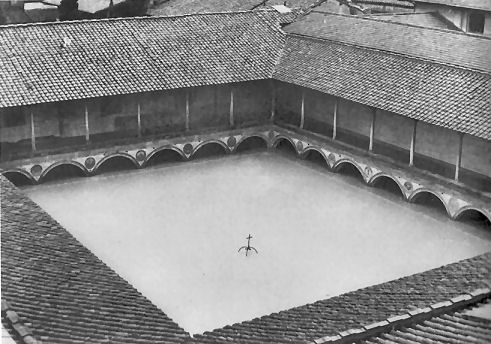 Death in the Tuscan Hills The fifth novel begins only months after the last. Bordelli has quit his job and spends his days in a country farmhouse that he's bought, walking, cooking, reading Dostoyevsky and indulging in some late-life gardening, that we get told about in maybe too much detail. Or maybe detailed instructions about how to prepare chicken-shit manure is your thing. The action of the previous book has left him with more recent demons, that now haunt him every bit as much as his wartime ones still do, and no longer having the law at his disposal he decides to take it into his own hands, to punish those left unpunished. He also gets a visit from the Contessa who lives in the castle on the hill, who still doubts that her lawyer son actually committed suicide fifteen years ago. So our hero is keeping busy. He's trying to quit smoking too, but his attitude to women remains period-appropriate - a thing of wistful and lustful gazes, cowardice and confusion. (And, as ever, none of the women or little girls go undescribed as to their appearance, and all are pretty.) Florence still looms large, despite Bordelli's move to the country - he still reminisces and visits enough to make the city the centre of the novel. The tide-marks and smell of heating oil remain from the flood, as normality only slowly returns. Our hero remains good company and a lovable sap, in many ways, as he juggles with morality and anger and his needs. An effortless readable and well-translated novel of pleasingly grey areas. The Italian title of this one translates as The Force of Destiny - not tourist-bait enough for the English language market, obviously. Ghosts of the Past This one, number six, was allowed to keep its very Bordelli Italian title, and is set just before Christmas 1967, so only months after number five. Inspector Bordelli is still living in the country, but commutes into Florence in his Beetle. He's also still pining like a schoolboy after his lost love, still giving up smoking and still lusting after every young woman he encounters, even ones he passes on the street. He's now nearing retirement age and so this drooling only gets more creepy. And again every woman is pretty, without exception, except if she's old. The case involves a widower of wealth found murdered with a duelling epee. The safe and the window have been left open, despite the cold, and a jewel box is missing. Bordelli and ask lots of questions and don't get far Then Bordelli discovers old friend Bruno Arcieri in a bar, in a very poor state, and takes him home, where Arcieri tells the story, in the third person and in a much smaller font, of how he came to be sunk so low. Capitano Arcieri is more a spy than a policeman, and is the creation of fellow-Florentine author Leonardo Gori, whose novels seem not to have been translated into English. Arcieri's side story, plotted by Gori but written by Vichi, recurs, alternating with the slow central murder investigation. The admiration of always-pretty women continues too, but if you can excuse this the story told, and the stories told by others along the way, makes for some good reading. In a crucial episode Bordelli is lead by a reluctant married woman into San Remigio (see left) and thence into a confessional for secrecy. Florence is conjured by addresses and street names rather than any descriptive passages, but the lives and characters conjured up have authenticity. This sixth Bordelli novel came out in 2018 and there's not been another one translated into English since, although there are now twelve of them in Italian, plus two short stories set in the 50s. It would be a shame if we get no more. |
|
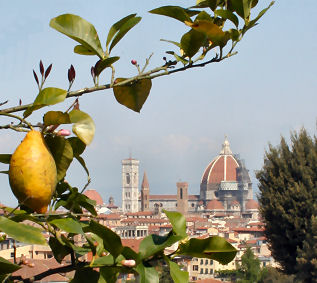
Sarah
Winman Still Life |
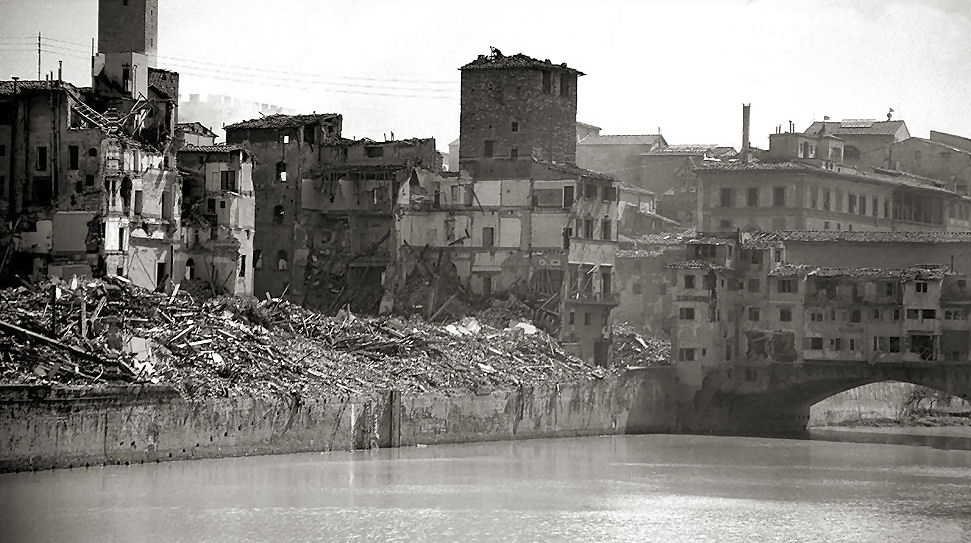

Even more partial and sparse than my Venice non-fiction
page, but there's some good stuff here.
I've also made a separate page for books of photos of
Lost
Florence
|
|
Diana Athill
A Florence Diary |
|
|
Ross King and Anja Grebe
|
|
|
|
|
Allison Levy House of
Secrets: The Many Lives of a Florentine Palazzo Beyond the handsome cover there are several annoying hurdles to be leapt before I can get into enjoying this one. Firstly the title: why does every pop-history book and TV documentary have to contain the word 'secret'. Call me picky but there can't be actual secrets involved, or they wouldn't be secrets! Also this is a book about the Palazzo Rucellai but the title keeps this fact a secret! This means that if you do a search on Amazon for Rucellai this book doesn't appear. Duh! Presumably it's a marketing thing, trying to attract the curious general reader rather than telling interested parties what they can expect. Then there's a short Preface full of so much fulsome touchy-feely psycho-babble that we seem to be threatened us with becoming intimate with the palazzo and its inhabitants rather than learning about them and keeping them at arm's length. We are encouraged to 'see built structures as social partners, equal players in the theaters of life and death.' Very un-British, and not just the spelling! Luckily the actual chapters settle down a lot and the history is readable. The intimate details of the author's relationship with her own older local patrician are thankfully, and surprisingly, withheld, and so become quite interesting interludes. The Rucellai family, Alberti the architect, their lives, and their works in the same vicinity get thoroughly introduced and discussed. I hadn't realised that San Pancrazio - site of the Rucellai chapel and Alberti's famous Tempietto - backs onto the Palazzo Rucellai, as getting from one to the other takes time and turnings if you're not a crow. The patchwork-building nature of the book makes for enjoyable variable reading, but can seem somewhat random at times. |
|
|
|
|
|
|
|
|
|
|
John Ruskin Mornings in Florence It's September 2018, and having begun listening to an Audible recording of Vasari, and started appreciating his strengths rather than his failings, here I am reading Ruskin and finding him to not be so much of a prig as I thought. I'm reading Mornings in Florence, in a handsome paperback bought on my last trip, and I got to the bit where he says of Santa Croce ...the ugliest gothic church you were ever in...no vaultings at all, which I've long quoted on my site's Santa Croce page. But reading on, beyond the famous quote, he goes on to say that though the design is not beautiful by any means it deserves, nevertheless, our thoughtfullest examination, and tellingly observes that the Franciscans' churches were meant for use; not show, nor self-glorification, nor town-glorification and that they had no intention of showing how high they could build towers, or how widely they could arch vaults. Which all makes the man sound much less harsh and grumpy than the initial quote does. But beyond this the pickings are slim - the mornings then repeatedly see returns to the Spanish Chapel in Santa Maria Novella with only the odd spark of interesting oddness and spleen-venting amongst the unfascinating theological observations and subject-listing. He deals with the sculpture panels up Giotto's Tower in exhausting detail. Another slim-picking enhancement of a famous quote, though, is with regard to the Ghirlandaio frescoes in S.M. Novella, which he says are simply good for nothing. He goes on to compare two of Ghirlandaio's scenes with a similar pair, that he says are by Giotto, in the Cloister of the Dead. His dismissal of Ghirlandaio's refinement in the face of the simple piety of the Trecento 'Giotto' frescoes is positively, and revealingly, Pre-Raphaelite! |
 |
|
|
|
Gert Jan van der Sman Lorenzo
and Giovanna - |
|
|
A.N.Wilson Dante in Love |
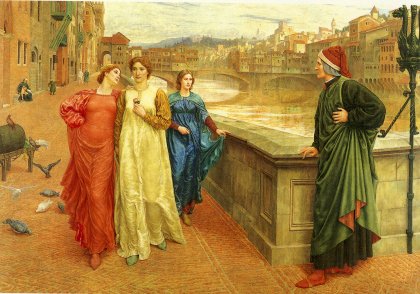 |